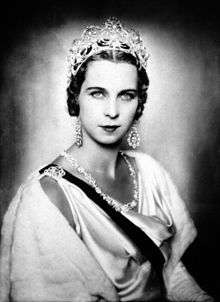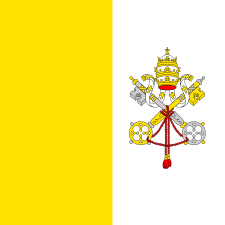Marie José of Belgium
| Marie José of Belgium | |||||
|---|---|---|---|---|---|
 | |||||
| Queen consort of Italy | |||||
| Tenure | 9 May 1946 – 12 June 1946 | ||||
| Born |
4 August 1906 Ostend, Belgium | ||||
| Died |
27 January 2001 (aged 94) Thonex, Switzerland | ||||
| Spouse | Umberto II of Italy | ||||
| Issue |
Princess Maria Pia Vittorio Emanuele, Prince of Naples Princess Maria Gabriella Princess Maria Beatrice | ||||
| |||||
| House | Saxe-Coburg and Gotha | ||||
| Father | Albert I of Belgium | ||||
| Mother | Elisabeth in Bavaria | ||||
| Religion | Roman Catholicism | ||||
| Styles of Queen Marie José | |
|---|---|
 | |
| Reference style | Her Majesty |
| Spoken style | Your Majesty |
| Alternative style | Ma'am |
Marie José of Belgium (Marie-José Charlotte Sophie Amélie Henriette Gabrielle; 4 August 1906 – 27 January 2001) was the last Queen of Italy. Her 35-day tenure as queen consort earned her the affectionate nickname "the May Queen".
Early life

Princess Marie-José was born in Ostend, the youngest child of Albert I, King of the Belgians and his consort, Duchess Elisabeth in Bavaria. During the First World War, she was evacuated to England where she was a boarding pupil at the Brentwood Ursuline Convent High School in Brentwood, Essex.
In 1924, Marie José attended her first court ball. For the occasion she was given an antique pearl and diamond tiara that had originally been owned by Stephanie de Beauharnais.[1]
Marriage and children
On 8 January 1930, she married in Rome Crown Prince Umberto of Italy, from the House of Savoy, and so became Princess of Piedmont (Italian: Principessa di Piemonte).
Among the wedding gifts was a turquoise and diamond parure, worn by the bride at her pre-wedding reception,[2] and a diamond bow worn as a sash decoration at state occasions.[3]
The couple had four children:
- Princess Maria Pia Louise of Savoy (24 September 1934), who married Prince Alexander of Yugoslavia on 12 February 1955 and was divorced in 1967. Four children were born during the marriage. She remarried Prince Michel of Bourbon-Parma in 2003
- Vittorio Emanuele, Prince of Naples (12 February 1937), who married Marina Ricolfi Doria on 7 October 1971. They have one son.
- Princess Maria Gabriella of Savoy (24 February 1940), who married Robert Zellinger de Balkany on 21 June 1969 and was divorced in November 1990. They have issue.
- Princess Maria Beatrice Caroline of Savoy (1943), who married Luis Reyna-Corvallán y Dillon on 1 April 1970, and has issue.
The princess would confess in an interview many years later, On n'a jamais été heureux ("We were never happy").
Princess of Piedmont
In October 1939, Princess Marie-José was made President of the Red Cross in Italy. The Princess and Duchess of Aosta attended the ceremony where Marie-José was installed as President of the Italian Red Cross.
During the Second World War she was one of the very few diplomatic channels between the German/Italian camp and the other European countries involved in the war, as she was the sister of Leopold III of Belgium (kept hostage by the German forces) and at the same time close to some of the ministers of Benito Mussolini's cabinet. A British diplomat in Rome recorded that the Princess of Piedmont was the only member of the Italian Royal Family with good political judgment.
In 1943, the Crown Princess involved herself in vain attempts to arrange a separate peace treaty between Italy and the United States; her interlocutor from the Vatican was Monsignor Giovanni Battista Montini, a senior diplomat who later became Pope Paul VI. Her attempts were not sponsored by the king and Umberto was not (directly, at least) involved in them. After her failure (she never met the American agents), she was sent with her children to Sarre, in Aosta Valley, and isolated from the political life of the Royal House.
She sympathized with the partisans, and while she was a refugee in Switzerland, smuggled weapons, money and food for them. She was even nominated for appointment as chief of a partisan brigade, but declined.
Queen for a month
Following Italy's defection to the Allied side in the war, her discredited father-in-law, King Victor Emmanuel III, withdrew from government. Her husband became acting monarch under the title of Lieutenant General of the Realm. He and Marie José toured war torn Italy, where they made a positive impression. However, King Victor Emmanuel III refused to abdicate until only weeks before the referendum.
Upon the eventual abdication on 9 May 1946 of her father-in-law, Marie-José became Queen consort of Italy, and remained such until the monarchy was abolished by plebiscite, on 2 June 1946. Umberto and Marie-José had been widely praised for their performance over the last two years, and it has been argued that had Victor Emmanuel abdicated sooner their relative popularity would have saved the monarchy. Following the monarchy's defeat (54–46%, a narrower margin than she had expected; she had feared that it might get as little as 10% support) she and her husband left the country for exile on 13 June 1946.
Separation
In exile, the family gathered for a brief time in Portugal, but she and Umberto decided to separate. She and their four children soon left for Switzerland where she lived most of the time for the rest of her life, while Umberto remained in Portugal. However, the couple never divorced, partly for political reasons. The republican constitution not only forbade the restoration of the monarchy, but also barred all male members of the House of Savoy, as well as former queens consort, from returning to Italian soil. Nonetheless, Umberto lived in hope (albeit declining over the years) of returning to the throne. Both were devout Catholics and felt divorce was potentially damaging to a Catholic king.
Death
For some time, she lived in Mexico with her daughter, Princess Marie-Beatrice, and her grandchildren.[4] Marie-José returned to Italy only after her husband had died in 1983. She died in a Geneva clinic of lung cancer at the age of 94, surviving her two brothers and some of her nieces and nephews. Marie José's death was instrumental in influencing the Italian government to amend its constitution to allow male members of the House of Savoy to visit Italy. The funeral was held at Hautecombe Abbey, in Savoy in the south of France, and attended by 2000 guests. Among them were Albert II of Belgium, Juan Carlos I of Spain and Farah Pahlavi, the last Empress of Iran.[5]
Marie-José was buried in Hautecombe Abbey beside her husband.
Like her mother, Queen Elisabeth, she inspired a musical contest: the Queen Marie José international musical composition prize, a bi-annual contest held in Switzerland since 2000.
Arms and Monogram
 |
 |
Titles, styles and honours
Titles
- 4 August 1906 – 8 January 1930: Her Royal Highness Princess Marie José of Belgium
- 8 January 1930 – 9 May 1946: Her Royal Highness The Princess of Piedmont
- 9 May 1946 – 18 June 1946: Her Majesty The Queen of Italy
- 18 June 1946 – 27 January 2001: Her Majesty Queen Marie José of Italy
Honours
National dynastic honours
-
_crowned.svg.png) House of Savoy: Knight Grand Cordon of the Royal Order of Saints Maurice and Lazarus[6][7][8]
House of Savoy: Knight Grand Cordon of the Royal Order of Saints Maurice and Lazarus[6][7][8]
National honours
-
 Holy See: Knight of the Order of the Golden Spur[9]
Holy See: Knight of the Order of the Golden Spur[9] -
.svg.png) Sovereign Military Order of Malta: Knight Grand Cross of Justice of the Sovereign Military Order of Malta, Special Class[10][11]
Sovereign Military Order of Malta: Knight Grand Cross of Justice of the Sovereign Military Order of Malta, Special Class[10][11]
Foreign honours
-
.svg.png) Austrian Imperial and Royal Family: Dame of the Imperial and Royal Order of the Starry Cross, 1st Class[9][12]
Austrian Imperial and Royal Family: Dame of the Imperial and Royal Order of the Starry Cross, 1st Class[9][12] -
.svg.png) Greek Royal Family: Dame Grand Cross of the Royal Order of Saints Olga and Sophia, 1st Class[13][14]
Greek Royal Family: Dame Grand Cross of the Royal Order of Saints Olga and Sophia, 1st Class[13][14]
Ancestry
See also
References
- ↑ "An antique and pearl tiara". Christies.
- ↑ "Fine antique turquoise and diamond parure". Christies.
- ↑ "Antique diamond bow". Christies.
- ↑ "worldroots.com". worldroots.com. Retrieved 2012-02-27.
- ↑ http://www.angelfire.com/de/verenasroyalty/ItalyFuneral2001.html
- ↑ https://s-media-cache-ak0.pinimg.com/564x/fd/b5/28/fdb528bc0c6ee9e7ff6ae80974ab888d.jpg
- ↑ http://desk.unita.it/cgi-bin/showimg2.cgi?file=F_BIO_L2_0160/00000029/0000168F.8d1ef419.jpg&t=big
- ↑ http://forum.alexanderpalace.org/index.php?topic=3269.315
- 1 2 altezzareale.com, Queen Marie Jose wearing the Roman Catholic orders of the golden spur and starry cross
- ↑ http://www.sothebys.com/content/dam/stb/lots/GE1/GE1505/963GE1505_8NKDL_comp_Queen_wearing_ring.jpg.thumb.319.319.png
- ↑ http://forum.alexanderpalace.org/index.php?topic=3269.360
- ↑ http://www.gettyimages.co.uk/detail/news-photo/the-queen-of-italy-marie-josé-of-belgium-and-her-husband-news-photo/495849340
- ↑ https://40.media.tumblr.com/8da888ffed859b925bb9f9d70f9f3988/tumblr_o07e3kmuxa1s14faro1_500.jpg
- ↑ https://s-media-cache-ak0.pinimg.com/236x/8a/2e/df/8a2edfb71aba068ae97b9be292658518.jpg
External links
| Wikimedia Commons has media related to Marie-José of Belgium. |
- Genealogy of the Royal Family of Belgium (House Saxe-Coburg-Gotha) at the Wayback Machine (archived October 28, 2009)
- Genealogy of the Royal Family of Italy (House of Savoy) at the Wayback Machine (archived October 28, 2009) - contains information about Marie-José's children and grandchildren.
- "The May Queen" from eurohistory.com
- Website of the "Queen Marie José international musical composition prize"
- short biography in February 2001 issue of "La Rondine"
- Italy's last queen dies BBC report
| Marie José of Belgium Cadet branch of the House of Wettin Born: 4 August 1906 Died: 27 January 2001 | ||
| Italian royalty | ||
|---|---|---|
| Preceded by Elena of Montenegro |
Queen consort of Italy 9 May – 12 June 1946 |
Monarchy abolished |